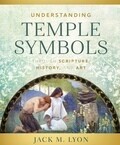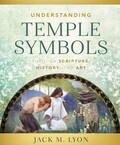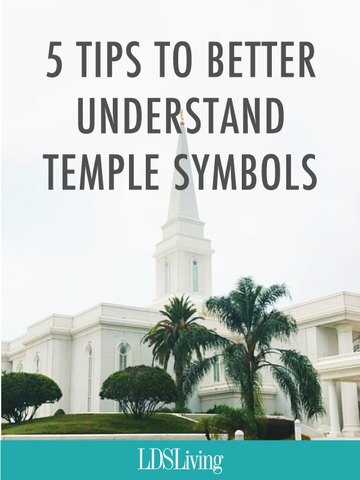
Why do temples have symbols? Where do symbols come from? Is all temple symbolism unique to Latter-day Saints? These and many more questions like them are answered in Jack M. Lyon's new book, Understanding Temple Symbols Through Scripture, History, and Art. Following is an excerpt that gives five tips to help Latter-day Saints better understand temple symbols.
The story of Adam and Eve is our individual story as well. Each of us walked and talked with God in the premortal life. After our mortal birth, we lived in the innocence of childhood. Then, as adults, we left our home to earn our bread by the sweat of our brow (see Moses 5:1). Now, in our difficulties, we may turn to God, seek his messengers, and ultimately find the gospel. (Even those born in the Church must go through this process, for conversion is an individual matter.)
We may marry and have children. We will certainly be confronted by Satan and learn by experience to know good from evil. As we mature in understanding and virtue, we may be sanctified by the Spirit, eventually becoming the kind of people who can dwell in celestial glory. Ultimately, we will die and, in the spirit world, await the resurrection. Pondering the endowment and the symbols surrounding it can bring important insights, helping us become better people in this life.
Here are a few tips to help you recognize and understand important, historic symbolism of the temple.
1. Remember that a symbol resembles the thing it stands for.
One key to understanding a symbol is that it often resembles the thing it stands for. For example, the bread and water of the sacrament represent the body and blood of the Savior—in that order. It would make no sense to have bread represent the Savior’s blood or to have water represent the Savior’s body. Bread, like flesh, is solid; water, like blood, is liquid.
Another example is the decoration embroidered on the clothing of the high priest in the Old Testament: “They made upon the hems of the [high priest’s] robe pomegranates of blue, and purple, and scarlet” (Exodus 39:24). Have you ever eaten a pomegranate? If so, you know that it is full of seeds. So the pomegranate can be seen as a symbol of fertility, of posterity. In addition, the juice of the pomegranate is red, suggesting blood, or life: “The life of all flesh is the blood thereof” (Leviticus 17:14).
After Adam and Eve partook of the forbidden fruit, “they knew that they were naked; and they sewed fig leaves together, and made themselves aprons” (Genesis 3:7). What color are fig leaves? Green, which symbolizes life and growth. Figs also contain hundreds of tiny seeds, so the fig, like the pomegranate, can represent fertility and posterity. In addition, it was only after the Fall that Adam and Eve were able to have children. As Eve said, “Were it not for our transgression we never should have had seed” (Moses 5:9–11).
2. Don't limit a symbols to just one meaning.
Just because a symbol represents one thing doesn’t mean it cannot represent another as well. For example, the “seed” that Eve mentioned (her posterity) also has another meaning: “The Lord God said unto the serpent, . . . I will put enmity between thee and the woman, and between thy seed and her seed; it shall bruise thy head, and thou shalt bruise his heel” (Genesis 3:14–15). The footnote in the Latter-day Saint edition of the Bible points out that the word translated here as “it” is really “he” in Hebrew: “he shall bruise thy head.” In addition, the footnotes explain, the Hebrew word translated as “bruise” can also mean “crush, or grind”: “he shall crush thy head.” Finally, in the original Hebrew, the word for “seed” is singular rather than plural; this verse refers to one specific “seed,” the Savior. Hebrews 2:14 explains, “As the children are partakers of flesh and blood, [Jesus] . . . himself . . . took part of the same; that through death he might destroy him that had the power of death, that is, the devil.”
Again consider the sacrament. Yes, the bread and water represent the Savior’s body and blood. But they also, in themselves, provide nourishment. Thus, they represent both death and life, showing that Jesus died so we might live. Baptism has these same two meanings. We go down into the water, which represents death, and we come up out of the water, which represents a new birth, both physical and spiritual: “We are buried with [Christ] by baptism into death: that like as Christ was raised up from the dead by the glory of the Father, even so we also should walk in newness of life. For if we have been planted together in the likeness of his death, we shall be also in the likeness of his resurrection” (Romans 6:3–5).
3. Remember that symbols are designed to raise questions in your mind.
As you participate in the endowment, the presentation may raise questions in your mind. That is by design, as questions can lead us to answers and to greater knowledge. So acknowledge your questions and use them as a starting point for further thinking and study. President Dieter F. Uchtdorf explained:
We are a question-asking people because we know that inquiry leads to truth. That is the way the Church got its start—from a young man who had questions. In fact, I’m not sure how one can discover truth without asking questions. In the scriptures you will rarely discover a revelation that didn’t come in response to a question. Whenever a question arose and Joseph Smith wasn’t sure of the answer, he approached the Lord, and the results are the wonderful revelations in the Doctrine and Covenants. Often the knowledge Joseph received extended far beyond the original question. That is because not only can the Lord answer the questions we ask but, even more importantly, He can give us answers to questions we should have asked. Let us listen to those answers. . . .God commands us to seek answers to our questions and asks only that we seek “with a sincere heart, with real intent, having faith in Christ.” When we do so, the truth of all things can be manifested to us “by the power of the Holy Ghost.” [“Reflection in the Water”]
Consider the depiction of Jesus’ nativity in one of the stained-glass windows of the magnificent cathedral in Chartres, France. The glaziers who made the windows were teaching in a symbolic way, much as we do in the temple. Look closely at the manger holding the baby Jesus. Do you notice anything unusual about it? Does it raise a question in your mind?
If you pause to ponder, you might realize that the manger resembles an altar—and that is by design. The artists who created that window wanted us to understand that this child in the manger would be offered as a sacrifice for sin. As the book of Hebrews says, “Neither by the blood of goats and calves, but by his own blood he entered . . . into the holy place [in the temple], having obtained eternal redemption for us” Hebrews 9:12). As Amulek explained, “It is expedient that there should be a great and last sacrifice, . . . and that great and last sacrifice will be the Son of God, yea, infinite and eternal” (Alma 34:13–14).
Here is another example, this time a verse from the Pearl of Great Price describing conditions in the time of Adam and Eve: “The Gospel began to be preached, from the beginning, being declared by holy angels sent forth from the presence of God” (Moses 5:58).
That verse raises a question: Who were these angels? Latter-day Saint scholar Hugh Nibley gave one explanation: “The Mandaean literature will tell you that the messengers that came to instruct Adam and Eve were the apostles who later became the pillars of the Church (Peter, James, and John)” (Ancient Documents and the Pearl of Great Price, 3). It is possible to take Brother Nibley’s statement at face value, for certainly the Lord later sent Peter, James, and John to Joseph Smith and Oliver Cowdery to restore the Melchizedek Priesthood. But his statement also raises other questions: “Why would Peter, James, and John visit Adam and Eve? Aren’t they from a completely different time period? Did they come as premortal spirits? What is going on here?” Possibly these messengers were not literally Peter, James, and John but symbolically represent any true messengers “sent forth” to visit “Adam and Eve” (us) here in mortality. The very word apostle, in the original Greek (apostolos), means “one who is sent.”
In the temple are a number of things we may have vaguely wondered about but haven’t actually thought about or researched. But we should! The process is like finding a loose bit of yarn on an old sweater. It’s easy to ignore that bit of yarn and just go on our way. But if we begin pulling on it, we may find it’s the end of a very long strand with all kinds of interesting twists and turns.
4. Remember that temple symbols can be explored through the scriptures.
S. Michael Wilcox, author of House of Glory, wrote:
Occasionally I have been asked if I can recommend a good book or article to help people understand the temple ordinances. I have always answered, “Yes! There is a wonderful manual written to explain even the most subtle meanings of the endowment, and it is readily available to you.” Excitedly the person takes out pencil and paper to write down the title. “The manual is the holy scriptures,” I say. Disappointed, the person puts down the pencil and says, “No, really. Is there any other book you would recommend?” [Page 19]
Brother Wilcox knows what he is talking about. If we start looking at the scriptures with the temple in mind, we will begin to see the many parallels between the two, and these parallels can enhance our understanding, even when the scriptures at first glance might not seem to be about the temple. Here is an example in the Doctrine and Covenants, from a revelation to President Brigham Young about how to organize the pioneer companies as they prepared to leave Winter Quarters and move west: “Let all the people of The Church of Jesus Christ of Latter-day Saints, and those who journey with them, be organized into companies, with a covenant and promise to keep all the commandments and statutes of the Lord our God” (D&C 136:2). This revelation was given as very practical instruction. And yet how many parallels with the temple are in that one short verse? And what can those parallels teach us? Aren’t we, too, on a journey together to Zion?
Another example is found in the Book of Mormon in which Alma discusses the Liahona. It includes many parallels that can enhance our understanding of the endowment:
And now, my son, I would that ye should understand that these things are not without a shadow; for as our fathers [Lehi and his family] were slothful to give heed to this compass (now these things were temporal) they did not prosper; even so it is with things which are spiritual. For behold, it is as easy to give heed to the word of Christ, which will point to you a straight course to eternal bliss, as it was for our fathers to give heed to this compass, which would point unto them a straight course to the promised land.
And now I say, is there not a type in this thing? For just as surely as this director did bring our fathers, by following its course, to the promised land, shall the words of Christ, if we follow their course, carry us beyond this vale of sorrow into a far better land of promise. [Alma 37:43–45]
5. Recognize that a valid interpretation of a symbol is compatible with the scriptures and gospel teachings.
The proper interpretation of temple symbols will always agree with the principles of the gospel as outlined in the scriptures and the words of the prophets. If we come to some other understanding, we can rest assured that we have it wrong, so we need to exercise caution. As the apostle Peter wrote, “No prophecy of the scripture is of any private interpretation. For the prophecy came not in old time by the will of man: but holy men of God spake as they were moved by the Holy Ghost” (2 Peter 1:20–21). In other words, we need to understand the endowment on its own terms and not force our own interpretations upon it. The endowment was designed to teach us certain things; we should try to understand those things and not fall into the condition of those who “despised the words of plainness, . . . and sought for things that they could not understand. Wherefore, because of their blindness, which blindness came by looking beyond the mark, they must needs fall; for God hath taken away his plainness from them, and delivered unto them many things which they cannot understand, because they desired it. And because they desired it God hath done it, that they may stumble” (Jacob 4:14).
Elder Gerald N. Lund warned that we must “fit the interpretation of any symbol into the overall scheme of gospel knowledge. No matter how clever, or how logical, or how ingenious our interpretation of a particular symbol may be, if it contradicts what is revealed in other places, we can assume it is wrong” (“Understanding Scriptural Symbols,” 24).
The above excerpt previously ran on LDS Living in December 2015. Lead image from Getty Images
For more specific insights into the symbolism behind the creation, Adam and Eve, and other temple-related topics, check out Understanding Temple Symbols Through Scripture, History, and Artby Jack M. Lyon, available at Deseret Book stores and at deseretbook.com.





